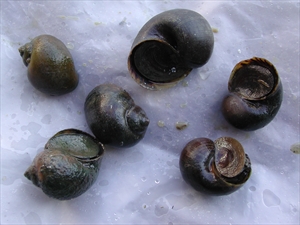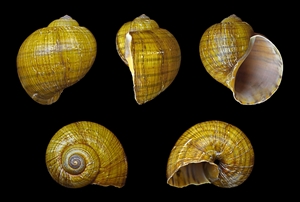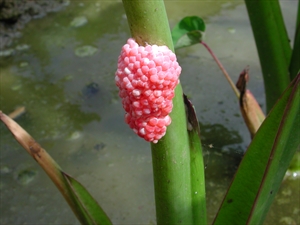Golden apple snail. The name has been given to several Pomacea species, due to confused identification.
Pacific Pests, Pathogens, Weeds & Pesticides - Online edition
Pacific Pests, Pathogens, Weeds & Pesticides
Golden apple snail (441)
Pomacea canaliculata. Other Pomacea species are similar, e.g., Pomacea maculata.
Asia, Africa (Egypt, South Africa), North and South America, the Caribbean (Dominican Republic), Europe (Spain), Oceania. In Papua New Guinea; NOT in Australia (intercepted only), nor in Palau (eradicated).
The snail is a generalist, and a large number of crops (rice, kangkong, lotus, taro, and many more) and wild species are hosts.
A freshwater pest of great importance in tropical and sub-tropical wetlands around the world, well adapted to periods of droughts and excessive rainfall.
Rice seedlings are cut just above the soil surface, and the stems and leaves are eaten. Taro leaves are eaten if they droop into the irrigation water. Large populations damage natural aquatic vegetation and displace local snail species. The snail is a hazard to human health.
Adults have thin shells, 35-60 mm high, which coils to the right (when apex is uppermost and opening is to the right), and varies from yellow brown, greenish-brown to dark brown, often with bands, with a brown horny operculum which closes the opening of the shell (Photo 1&2). Albino and gold forms exist (Photo 3). The body is golden-pinkish or orange-yellow. Tentacles are long and tapering. The snails have gills and a lung.
Female snails lays clutches of pink eggs (about 250 at a time, but this is very variable), above water on parts of plants and on rocks (Photo 4). The eggs hatch after about 2 weeks, depending on temperature, and the young fall into the water. The length of the life cycle depends very much on temperature and the occurrence of seasons.
Spread occurs by floating in water, and crawling. Over large distances, spread is helped by the aquarium trade, purposely as a human food, and on planting material, such as sets ('tops') of taro. The snails survive dry times by burying into the mud to hibernate for up to 6 months.
Impacts occur in many Southeast Asian countries where rice is direct seeded (the Philippines, Thailand, Vietnam). For instance, in the Philippines, where the snail occurs over approximately 50% of the area devoted to the crop, losses in yield, replanting, and pesticide use cost many millions of dollars annually. In Thailand, high losses of aquatic vegetation from snail grazing resulted in phosphorus release and concomitant outbreaks of phytoplankton. Loss of native snails in many places is considered a direct result from apple snail introductions and/or an indirect result from pesticide use to control them. And in south China and Taiwan eating the snail raw (a delicacy) has resulted in numerous cases of meningitis, caused by the parasitic nematode, Angiostrongyulus cantonensis, the rat lungworm.
Look for the bright pink egg masses which are characteristic of Pomacea species. However, the variability of the species make identification difficult, and specimens should be examined by experts. This applies particularly to Pomacea canaliculata and Pomacea maculata which look very similar. There are molecular method to separate some species.
BIOSECURITY
The golden apple snail is on the list of the 100 of the World's Worst Invasive Species compiled by the Global Invasive Species Database, maintained by the IUCN Invasive Species Specialist Group.
Countries still free from the golden apple snail should take all practical measures to prevent its introduction and further spread. Although now widespread in Asia, it is not present in Australia, or in any Pacific islands country other than Papua New Guinea.
NATURAL ENEMIES
Egg and small juveniles are eaten by fire ants; and there are birds that specialise in adults. There are other birds, lizards, fish, crabs, and rats that will prey on juveniles.
CULTURAL CONTROL
Before planting:
- Plough and harrow the land to kill the snails in the soil; if rice is the next crop flood the land to revive dormant snails and then cultivate.
- Transplant rice at 3-4 weeks rather than direct seeding as the leaves are no longer palatable to the snails.
- Increase seedling rates to compensate for potential damage later.
- Add NPK fertilizer during soil preparation. It is said to be toxic to the snails.
During growth:
- Periodically lower the irrigation water to about 1-2 cm to prevent the snails from moving and feeding.
- Hand collect snails and eggs in small plantings. Stakes or sticks can be placed in fields (rice and taro) as egg-laying sites that can be collected easily and destroyed. Shallow canals at the sides of fields help with collection too.
- Keep weeds in check around paddies and on bunds so snails can be seen easily.
- Breed ducks (Indian runners) and allow them entry to rice and taro fields when the seedling (rice at 4 weeks) and setts (taro) are established, or allow entry before transplanting.
After harvest:
- Burn straw and stubble to destroy the snails.
- In taro fields, rotate with legume cover crops.
CHEMICAL CONTROL
This is not a method that can be recommended: molluscicides are expensive and some are toxic to human beings. Note that metaldehyde pelleted baits have come under scrutiny by pesticide regulators and countries are reconsidering their use. For instance, a ban on the outdoor use of metaldehyde will be introduced in the UK from March 2022. It can be used in permanent greenhouses. It poses an unacceptable risk to birds and mammals.
____________________
When using a pesticide, always wear protective clothing and follow the instructions on the product label, such as dosage, timing of application, and pre-harvest interval. Recommendations will vary with the crop and system of cultivation. Expert advice on the most appropriate pesticide to use should always be sought from local agricultural authorities.
AUTHOR Grahame Jackson
Information from CABI (2019) Pomacea canaliculata (golden apple snail). Crop Protection Compendium. (https://www.cabi.org/cpc/datasheet/68490); and Pomacea canaliculata. Wikipedia. (https://en.wikipedia.org/wiki/Pomacea_canaliculata); and from Golden apple snail (undated) Rice Knowledge Bank. IRRI. (http://www.knowledgebank.irri.org/step-by-step-production/growth/pests-and-diseases/golden-apple-snails). Photo 2 H. Zell. Pomacea canaliculata, Ampullariidae: H Zell Pomacea canaliculata, Ampullariidae. Wikimedia Commons. (https://commons.wikimedia.org/wiki/File:Pomacea_canaliculata_01.JPG). Photo 3 Florida Division of Plant Industry. Florida Department of Agriculture and Consumer Services, Bugwood.org.
Produced with support from the Australian Centre for International Agricultural Research under project HORT/2016/185: Responding to emerging pest and disease threats to horticulture in the Pacific islands, implemented by the University of Queensland and the Secretariat of the Pacific.







